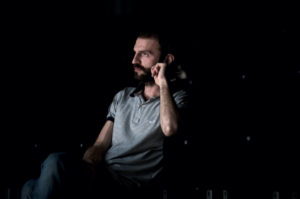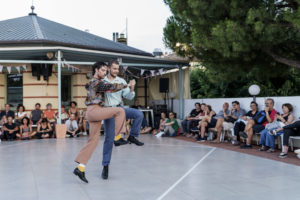Save the Last Dance: The polka chinata returns, the same but different - Vancouver Ballet Society
- Home
- Features 2020 - 2023
- Save the Last Dance: The polka chinata returns, the same but different

By Rachel Silver Maddock
In the Italian folk dance the polka chinata, two men embrace, bending their knees and spinning in circles low to the ground. The Bolognese courtship dance from the early 1900s is difficult, exhausting, and requires hours of training to perfect. “It’s about how to deal with the weight of each other, how to maintain equilibrium together,” Alessandro Sciarroni explains.
The Italian choreographer, the 2019 recipient of the Venice Biennale’s Golden Lion for Lifetime Achievement in Dance, came across the polka chinata (chinata means bent down or crouching) in 2018 and was immediately fascinated by it — the spinning, the endurance required, and the fact that at that time only five people in Italy still practised it. The dance had faded into history since World War Two but was brought back to life in 2015 by Giancarlo Stagni, a ballroom dance master who discovered videos of men dancing it in the 1960s.

“It was amazing for me to think that 120 years ago it was possible for two men to hug and spin together like this,” Sciarroni says. The dance traditionally allowed men to show off their strength and stamina to unmarried women at a time in Italy when male and female life before marriage was very separate.
Sciarroni wanted to stage the polka chinata in a contemporary context. It aligned with a number of his longtime research interests — ideas of endurance, spinning, insisting on a single movement, and obsession. He connected dancers Gianmaria Borzillo and Giovanfrancesco Giannini with Stagni, and they travelled to a small city near Bologna every week for six months for lessons.
The resulting work, Save the Last Dance for Me, came together in a whirlwind nine-day residency, premiering at an Italian dance festival in 2019. In the 20-minute piece, Borzillo and Giannini expertly perform the polka chinata to an electronic score.
The show is always accompanied by a series of public workshops. “With [Stagni] and curators of the festivals, we decided it was important to create a series of workshops to teach with the piece, to find a way to keep the tradition alive,” Sciarroni says.

Since its premiere, the work has been performed over 100 times in Europe and North America (and will tour to Hong Kong in May). Sciarroni says the strong response is connected to the amount of empathy created with the audience during the work; the movement score is very demanding, and the audience can see the physical exertion of the performers. Smiling is a performative tool that helps Borzillo and Giannini find pleasure in the effort, and receive energy back when they need it most.
Although it wasn’t Sciarroni’s main focus, audiences are reading further into the relationship between the two men — and engaging critically with notions of masculinity and gender roles. “We never thought about the fact they are two young beautiful men dancing together. We never thought about how someone could read something about love or a relationship,” says Sciarroni. Because of the rushed pace of creation, dramaturgy was the last thing on their minds during the choreographic process. “But if I have the chance to show there is something else in this, then why not? The audience was very open to other meanings.”

The public engagement side of the work is not only important, but lively and fun — Sciarroni says men and women attend from all walks of life, amateur to professional, to learn the polka chinata. “They come just to be together. It is quite fun to carry the weight of your partner, and it can be quite hilarious,” he says.
The true success of Save the Last Dance for Me is that the polka chinata has once again become part of the cultural life of Italy. Sciarroni says in the last five years the dance has been performed at music festivals and featured at concerts by popular mainstream musicians. Many more people know about the dance and practise it. The story is an encouraging one, and reveals the strength of cultural traditions.
“Dance doesn’t go into extinction like animals or plants,” Sciarroni says. “Dance has a capacity to disappear for entire generations and then reappear again.” He adds optimistically, “I don’t think we have to be worried about the preservation of some traditions… in a way they are stronger than us.”
Save the Last Dance for Me is at the Vancouver International Dance Festival March 10-15.

